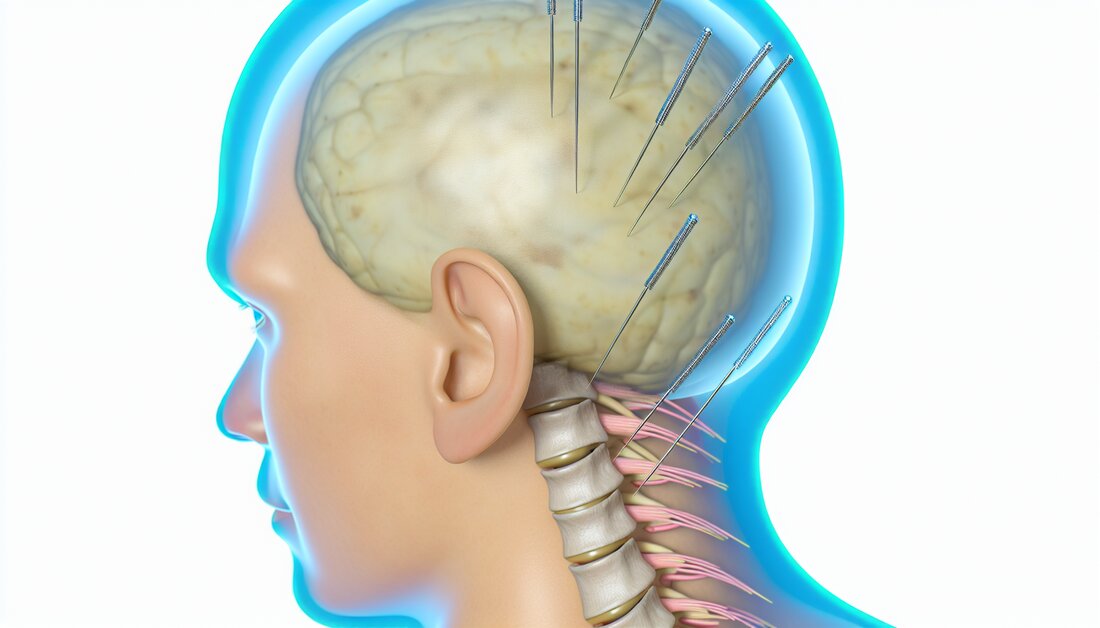Scalp Acupuncture: Rapid Recovery from Spinal Cord Injury
Scalp acupuncture promotes impressive motor recovery for spinal cord injuries. Case study shows: Combined with physiotherapy, it improves movement function in just 21 days.

Scalp Acupuncture: Rapid Recovery from Spinal Cord Injury
Spinal cord injuries (SCI) are one of the main causes of lifelong motor impairments and are often associated with significant secondary complications. Different treatment approaches are necessary to promote early functional recovery. These typically include surgery, stem cell therapy, medication and physical therapy. However, recent research also shows promising results when using acupuncture to promote neuronal plasticity.
A new report describes a case in which a spinal cord injury occurred in the form of a vertebral fracture at the L3 level. The patient was treated with scalp acupuncture combined with physiotherapy exercises for 21 days. Activation of the motor area in the brain was observed after the first day of treatment. The patient was able to fully regain strength and range of motion in his knees. After 21 days, there were significantly improved motor recovery and functional results that could not be observed in the previous six months.
These results suggest that the combination of scalp acupuncture and intensive physical therapy can significantly contribute to motor recovery after spinal cord injury. Future use of this therapy could result in a rethinking of the current treatment routine for SCI by placing greater focus on complementary, non-invasive treatment methods.
Basic terms and concepts:
- Rückenmarksverletzung (SCI): Eine Schädigung des Rückenmarks, die zu einem teilweise oder vollständigen Verlust der motorischen Funktion und/oder Sensibilität führt.
- Neuronale Plastizität: Die Fähigkeit des Nervensystems, sich an Verletzungen oder neue Erfahrungen anzupassen, oft durch die Bildung neuer neuronaler Verbindungen.
- Akupunktur: Eine alternative medizinische Praxis, bei der feine Nadeln an bestimmten Punkten des Körpers eingeführt werden, um Schmerzen zu lindern oder Funktionen zu verbessern.
- Physiotherapie: Behandlungsmethode zur Verbesserung der körperlichen Funktion von Patienten durch Übungen, manuelle Techniken und andere therapeutische Ansätze.
- Burstfraktur: Eine spezifische Art von Wirbelbruch, bei der der Wirbelkörper in mehrere Teile zerspringt.
Abbreviations:
- SCI: Spinal Cord Injury (Rückenmarksverletzung)
- L3: Bezeichnung für den dritten Lendenwirbel
Importance of the combination of head acupuncture and physiotherapy for spinal cord injuries
This study examines the use of head acupuncture in conjunction with intensive physical therapy to promote motor recovery after spinal cord injury (SCI). The present case concerns a compression fracture at the L3 level, which is a major cause of lifelong motor impairment and is associated with significant secondary complications. Traditional treatments include surgery, stem cell therapy, drug treatment and physical therapy. Acupuncture has received particular attention because of its potential to modulate neuronal plasticity.
Study results
- Der Patient erhielt über 21 Tage eine Behandlung, bestehend aus Kopfakupunktur und stationärer Physiotherapie.
- Bereits nach dem ersten Behandlungstag wurde eine Aktivierung des motorischen Bereichs festgestellt.
- Der Patient erlangte vollständige Kraft und Bewegungsumfang in den Knien wieder.
- Die motorische Erholung und die funktionalen Ergebnisse verbesserten sich signifikant im Vergleich zu den sechs Monaten vor Therapiebeginn.
These results show that the combination of head acupuncture and intensive physical therapy has the potential to significantly improve motor recovery after spinal cord injury.
Summary of the study
The main conclusion of the study is that not only traditional treatment methods for spinal cord injuries should be considered, but alternative approaches such as acupuncture can also play a crucial role. The rapid activation of the motor cortex and the significant improvement in functionality within the treatment period demonstrate the high potential of these combined therapeutic approaches. These observations suggest that integrative treatment that includes various therapeutic modalities may lead to better neurological and functional outcomes.

 Suche
Suche
 Mein Konto
Mein Konto
